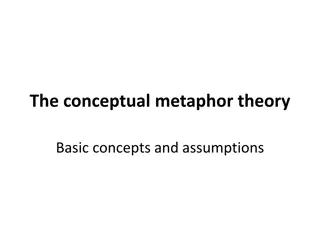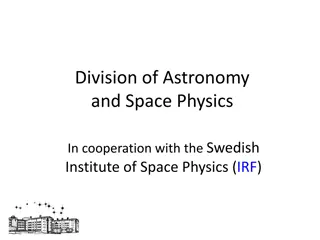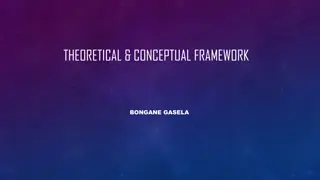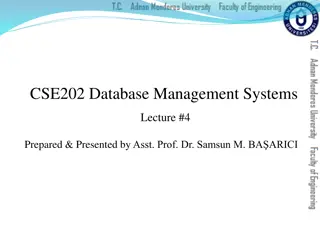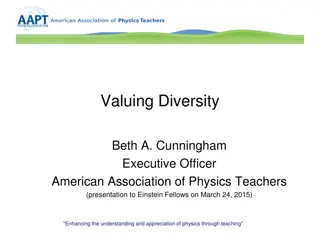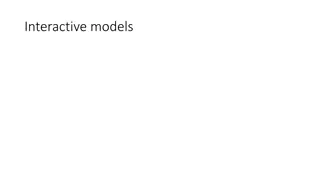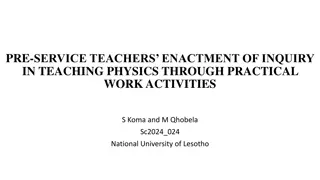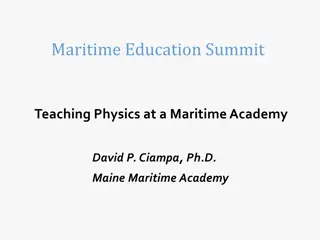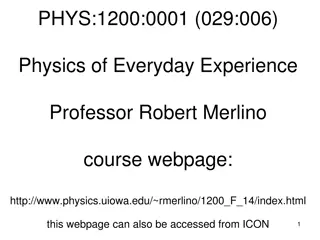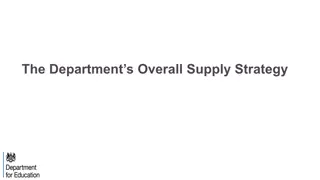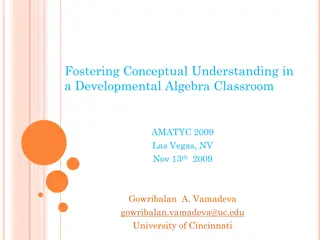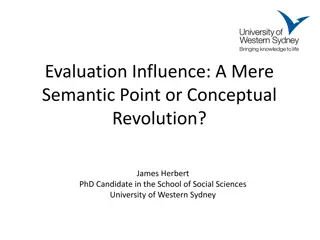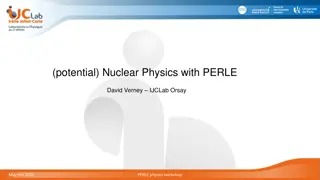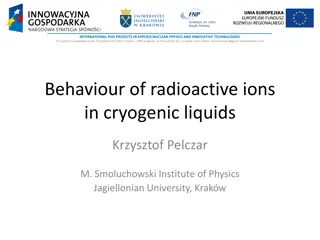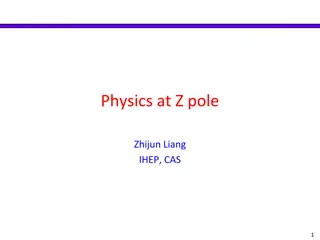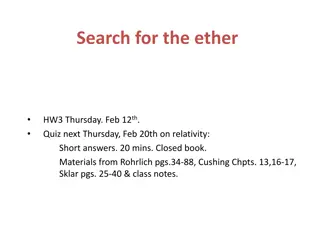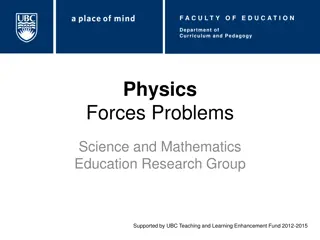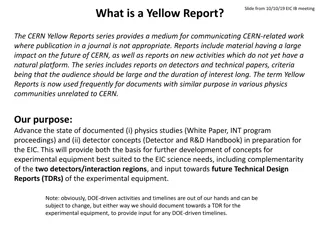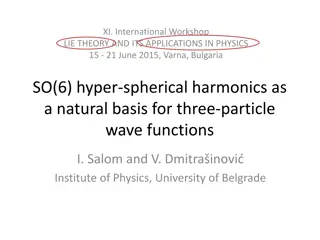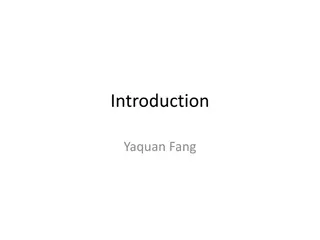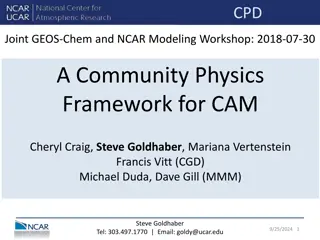The Impact of Interactive Teaching on Conceptual Development in Physics
Investigating the effectiveness of interactive teaching in promoting conceptual development in physics, focusing on student learning in both conventional and interactive classrooms. Research examines student understanding through qualitative reasoning questions, such as the baseball bat scenario, to improve instructional methods based on empirical data and analysis.
Download Presentation

Please find below an Image/Link to download the presentation.
The content on the website is provided AS IS for your information and personal use only. It may not be sold, licensed, or shared on other websites without obtaining consent from the author. Download presentation by click this link. If you encounter any issues during the download, it is possible that the publisher has removed the file from their server.
E N D
Presentation Transcript
Is interactive teaching sufficient to promote conceptual development in physics? Paula Heron Department of Physics University of Washington Seattle, USA
UW Physics Education Group Faculty Paula Heron Lillian McDermott Peter Shaffer Physics PhD Students Paul Emigh Ryan Hazelton Alexis Olsho Brian Stephanik Marshall Styczinski Tong Wan Lecturers and postdocs Ximena Cid Donna Messina Gina Passante
Outline Investigating student learning in conventional and interactive classrooms Using research as a basis for improving instruction Focus on introductory physics but PER is also highly relevant for advanced courses (ask me after the talk)
PART ONE Investigating student learning in conventional and interactive classrooms: Probing student understanding with written questions that require qualitative reasoning
The baseball bat question A student balances a baseball bat on a finger. Is the center of mass to the right, to the left, or at point P? Is the mass to the left greater then, less than, or equal to the mass to the right? Explain your reasoning.
Sample correct response If you were to consider each of the pieces to have a center of mass of their own, the xcm on A would be at a farther distance from the break. mA would be smaller than mB whose xcm is not as far away from the break. Correct response given by 20% of students (N > 1000) at UW
Sample incorrect responses To be able to balance the bat, the forces on the right of P and the forces on the left of P cancel each other out the masses [to left and right of P] are equal. mA = mB. The term center of mass, when translated into everyday English means the center of mass, i.e., if separated at the center, half will be on one side and half on the other.
Maybe students responded incorrectly because: they are not very smart they had not been taught the relevant material they had beentaught the material, badly they misunderstood the question or made unintended assumptions they were misled by the term center of mass they weren t taking the question seriously they ignored their correct intuition because it was a physics test they haven t had enough real-world experience ( kids today ) Most of these explanations, while reasonable, are not supported by evidence
Baseball bat question: Results 5 of students 100% 90% 80% % of students in class answering correctly 70% No university-level instruction on torque, equilibrium etc. 60% 50% 40% 30% 20% 10% 0% 1 2 3 4 5 6 7 8 9 10 Class label
Baseball bat question: Results 5 of students 100% 90% All instruction on torque, equilibrium etc., in intro physics 80% % of students in class answering correctly 70% 60% 50% 40% 30% 20% 10% 0% 1 2 3 4 5 6 7 8 9 10 Class label
On questions that elicit intuitive notions (e.g., about force, motion, charge, buoyancy, balancing, etc.), performance is often essentially the same before and after instruction.
More evidence: A question on acceleration A ball rolls up and then down an incline as shown in a strobe photo. What is the direction of the acceleration of the ball at the top of its path? Given in 79 classes of different size, that met at different times of day, used different textbooks, had different amounts of lecture instruction by different people
A question on acceleration: Results Results arranged chronologically 100% 90% 80% 70% % of 60% students giving the correct answer 50% 40% 30% 20% 10% 0% 1998 2000 2002 2004 2006 2008 2010 2012 Heron, 2014
A question on acceleration: Results Results arranged according to whether or not instruction on acceleration had taken place. 100% 90% 80% % of 70% students giving the correct answer 60% BEFORE INSTRUCTION 50% AFTER INSTRUCTION 40% 30% 20% 10% 0% Heron, 2014
More evidence: A question on capacitance that (apparently) requires more formal knowledge As the (oppositely charged, isolated) plates are moved closer together, does the capacitance of the arrangement increase, decrease or remain the same? - 0+ 0 Metal plates on insulating stands
A question on capacitance: Results 100% 90% 80% 70% % of 60% students giving the correct answer BEFORE INSTRUCTION 50% AFTER INSTRUCTION 40% 30% 20% 10% 0% 0 0.5 1 1.5 2 2.5 Heron, 2014
Still more evidence: A question on diffraction Monochromatic light of wavelength is incident on a mask with a slit of width w. The diffraction pattern shown appears on a distant screen. Is the width of the slit w greater than less than or equal to the wavelength ?
A question on diffraction: Results 100% 90% 80% 70% % of 60% students giving the correct answer BEFORE INSTRUCTION 50% AFTER INSTRUCTION 40% 30% 20% 10% 0% 0 0.5 1 1.5 2 2.5 Heron, 2014
Even on questions for which one might not expect students to have preconceptions (e.g., capacitance, flux, phase difference), the effect of instruction is often small.
Effect of perceived effectiveness of the instructor Pairs of instructors teaching parallel sections with common exams 7% 6% y = 0.0162x - 0.0025 R = 0.3027 5% 4% 3% Difference in % of exam questions answered correctly 2% 1% 0% 0 0.5 1 1.5 2 2.5 -1% -2% -3% -4% Difference in student rating of instructor effectiveness (out of 5)
So the solution is interactive teaching, right? Maybe, sort of.
The effect of additional instruction: Example from Introductory Physics A demonstration based on the bat question was performed by a professor familiar with our research 40% answered the bat question correctly several days later (N = 84) Common incorrect response: mA = mB like Professor X showed us in class. Also, if they weren t equal, the bat would tip over.
There is a strong tendency to see what one expects. McCloskey, Sci. Amer. (1983). Confronting incorrect ideas may be insufficient; most students need help resolving the underlying conceptual difficulties.
The effect of additional instruction: Example from second-year engineering statics at UW Students had a three-hour session on centroids and center of mass Worked in small groups Made predictions about the location of the center of mass of assorted shapes Checked their predictions with real apparatus 15% later answered the bat question correctly (N > 70)
Certain conceptual and reasoning difficulties are not addressed by traditional instruction. Even pedagogically correct instruction may not address serious and persistent difficulties. Instruction should be evidence-based not ideology-based
Interactive teaching (aka active learning) Most (all?) demonstrably effective instructional strategies are interactive; not all interactive instructional strategies are effective Terms are not operationally defined How do we know learning is active? How can we tell whether students are engaged? The form of instruction is only ONE ingredient
Evidence from decades of systematic research suggests that: knowledge is developed through construction, not accretion or absorption. Students have already constructed considerable knowledge by the time they reach our classrooms. Passive listening doesn t foster (re)construction of existing knowledge (for most students).
Implications for instruction Instruction needs to match How people learn What they already know Research-based instruction differs from traditional instruction in: Style: Students must be actively engaged in learning AND Content: Instruction must meet students where they are
How can student difficulties be addressed while respecting existing instructional constraints? Need for flexible, research-based instructional materials.
Tutorials in Introductory Physics A set of instructional materials to supplement instruction in large introductory courses General goals: Constructing concepts Developing reasoning ability Relating physics formalism to the real world General instructional strategies: Teaching is by questioning (not by telling) Discussions among students are emphasized Specific goals and strategies are determined by research
Introductory calculus-based physics at UW ~1500 students at any one time (physics & engineering majors) Standard textbook Weekly schedule: lectures (3 x 1hr) laboratory session (1 x 2hr) tutorial session (1 x 1hr) homework problems from textbook (online) Instruction by faculty and graduate teaching assistants
Basic features of tutorial system at UW small groups (3-4) work through worksheets tutorial instructors (TAs) teach by questioning all course examinations include questions on tutorial material
Matching a tutorial strategy to a difficulty Difficulty: Assumption that if there is equal mass (weight/force) on both sides of the fulcrum then the object will balance Strategy: Help students recognize that equal mass on both sides of the fulcrum is neither necessary nor sufficient to ensure balancing
Example of a tutorial activity Hang board from hole to right of center of mass. Use clay to balance the board. Predict how the total mass to the right of the pivot compares to the total mass to the left. a. Move the clay toward the pivot. Does the board remain balanced? Does the total mass to either side of the pivot change? b. Balance board again, with larger piece of clay. Does the total mass to either side of the pivot change?
How do we know if a tutorial helped? Results from many questions administered under a wide range of conditions suggest that randomized control trials are not necessary for detecting instructionally significant effects.
Baseball bat question: Results No student saw the same question twice* 5 of students 100% tutorial 90% 80% % of students in class answering correctly 70% Bat demo 60% 50% 40% 30% 20% 10% 0% 1 2 3 4 5 6 7 8 9 10 Class label * The bat demo is an exception
PART TWO Using research on how students learn and what they know as a basis for improving instruction: An iterative process.
The free small ball problem A small ball moves without spinning or interacting with any other objects. At the instant shown, what is the direction of the angular momentum of the ball with respect to point B (Lball,B)? If this quantity is zero, state so explicitly.
The free small ball problem A small ball moves without spinning or interacting with any other objects. p At the instant shown, what is the direction of the angular momentum of the ball with respect to point B (Lball,B)? If this quantity is zero, state so explicitly. r Correct response given by 30% after instruction (N = 340) Lball,B points into the page. By the right hand rule the angular momentum will be orthogonal to the plane of the position and momentum. Out of page also accepted
The free small ball problem A small ball moves without spinning or interacting with any other objects. p At the instant shown, what is the direction of the angular momentum of the ball with respect to point B (Lball,B)? If this quantity is zero, state so explicitly. r Common incorrect response (20%) Lball,B is zero. Since there is no rotation, the angular momentum is zero.
Excerpt from initial tutorial on Conservation of Angular Momentum rA,C rA,C r p p r|| Apply definition: LA,C = rA,C p Students explore direction, reference-point-dependence, and time-independence
The free small ball problem: Results 100% 90% 80% % of students in class answering correctly 70% 60% AFTER CONVENTIONAL 50% AFTER TUTORIAL 40% 30% 20% 10% 0%
Further assessment: Ball and rod In two separate experiments a ball collides with and sticks to a rod on a level frictionless surface. The center of the rod is initially at point A. Linear momentum vectors Experiment 1 Experiment 2 Draw linear momentum (p) vectors for the ball/rod system: Before collision After collision Angular momentum vectors Experiment 1 zero zero Experiment 2 Out of pg Out of pg Indicate direction of L of ball/rod system about point A: Before collision After collision
Ball and rod problem: Results correct Linear momentum vectors Experiment 1 Experiment 2 Before collision 40% After collision Angular momentum vectors Experiment 1 zero zero Experiment 2 Out of pg Out of pg Before collision 15% After collision
Angular momentum of a particle: Results 100% 90% no context 80% Collision context 70% 60% AFTER CONVENTIONAL 50% AFTER TUTORIAL AFTER TUTORIAL 40% 30% 20% 10% 0%
Ball and rod problem: Common incorrect response (~ 50% of students) Linear momentum vectors Experiment 1 Experiment 2 Before collision After collision Angular momentum vectors Experiment 1 zero zero Experiment 2 zero non-zero Before collision After collision
Excerpt from interview based on the ball and rod problem I: What if I could show you photos that showed that the ball/rod system moves forward at the same rate in both experiments? What would you think of that? S: That would be hard for me to figure out in my head because it seems like you re not having a conservation type of situation. Seems like this one (Exp. 2) has more energy going into it than this one (Exp. 1). I: How s that? S: Because that s moving in more dimensions, therefore more is going on.
I: More is going on, OK. You mentioned energy. Does it violate momentum conservation? S: Yes, I think it would, because what I ve been saying before is that I think angular momentum plus the translational momentum would have to equal some sort of constant. I: What s that based on? S: What s that based on? Empirical knowledge. I don t know. Just what I ve seen in the real world.
Insight from written exams, corroborated by interviews Students are applying the idea of conservation (but not to the right quantities) This gives us something to work with
Outline of revised tutorial: Students: consider collisions like those in the Ball and rod problem and predict how forward motions (vcm) compare use photographs to check their predictions discuss whether p and L are conserved separately or together (as a single, combined quantity). THEN - the tutorial introduces angular momentum of a particle as a means of saving angular momentum conservation.





